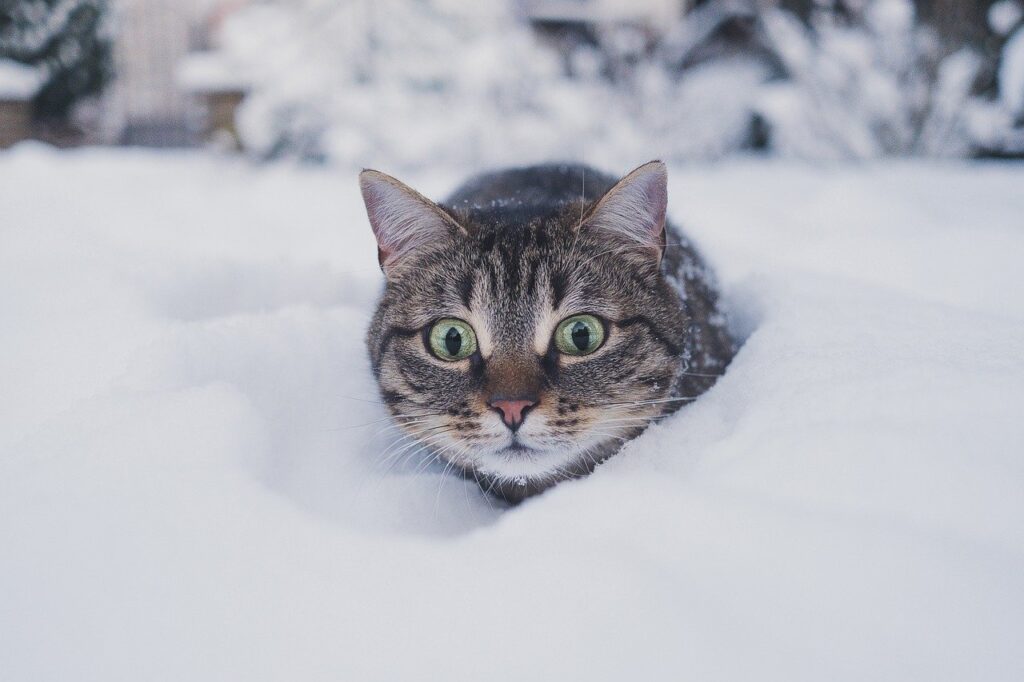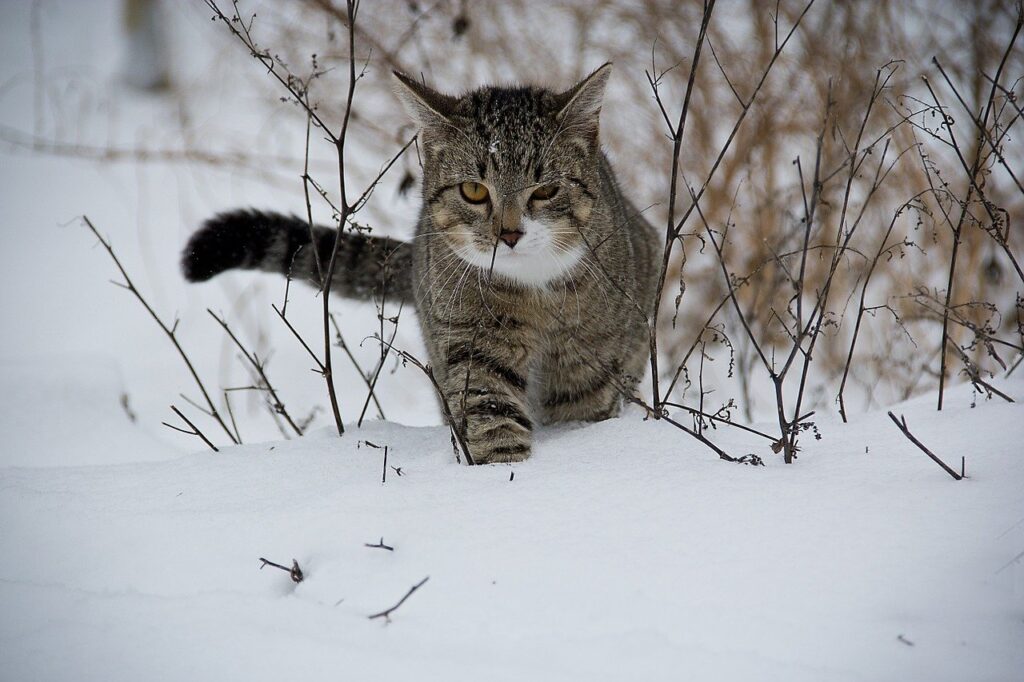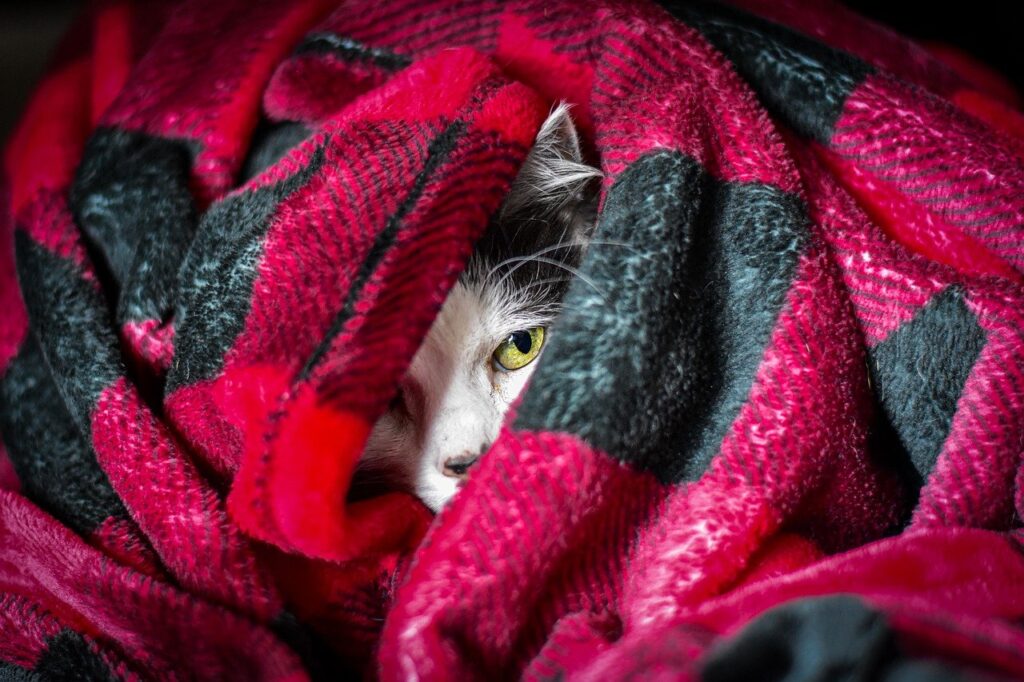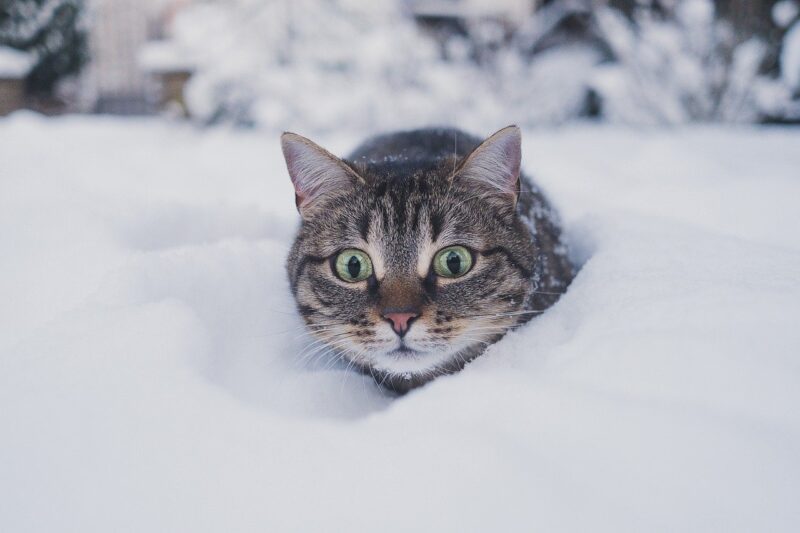You must have noticed a random stray cat strolling the neighborhood. You might be curious about how they remain warm throughout this bitter winter weather, and you might even be thinking to bring one in your home to keep it safe from the extreme weather.
How do cats survive the winter? Cats are unlikely to fall victim to the consequences of freezing climates since they are skilled at taking shelter (and since they can squeeze into a compact, enclosed location). Even so, sub-zero temperatures can create major medical problems such as frostbite and hypothermia, and both of them can be fatal.
What would you be doing if you notice a feline out there during the cold? Read on this article to know what temperatures a cat can survive and how you can keep them warm.
How well can cats thrive in extreme cold?
Younger felines are able to tolerate lower temperatures better than senior cats or pets with illnesses like arthritis. It would also be determined by the amount of food available to the feline.
They’ll need more nutrients if they’re likely to be outdoor in the freezing temperatures. It also varies based on whether the feline is strictly indoors or has a proper exit outside.
Outdoor felines are more knowledgeable about their way around the neighborhood and where they could stay safe in the cold. Domestic kitties do not have this experience and, as a result, are more fearful if required to stay outside.

Frostbite and hypothermia are more prone to show up at temperatures of 32℉ or 0°C; however, your feline may also be miserable at a higher temperature. It varies according to the cat’s body temperature.
Some people believe that long-haired felines can withstand colder weather. Although some cat species have fur that assists in warming them up in the winter, cats are nonetheless prone to hypothermia and frostbite.
Hypothermia happens only when the internal temperature goes under 100°F (37.8°C). A feline’s typical body temperature totally depends on breed, although it is usually about 102°F (38.9°C).
Frostbite could occur in any part of the body that has been subjected to extreme cold for a long period of time. The most typically damaged parts are the ears, tails, and footpads.
It’s possible that you won’t notice the signs of frostbite for several days, this implies that the problem might worsen. Both frostbite and hypothermia would require treatment from your vet.
Although most individuals are informed that they should never keep their feline, or any animal, in the vehicle on a humid day, other folks feel that they would be safe in the vehicle during the winter. In reality, a cold car may be just as deadly as a hot one. It basically transforms into a freezer, and felines can quickly die from hypothermia.
Also, your garage might also seem to be an ideal winter shelter for your feline. The huge number of garages contain potential dangers. Felines are toxic to antifreeze, industrial cleaners, and ice melting agents, all of which are stored in garages. Even licking antifreeze from their coat might be harmful.
Some people park their vehicles in their sheds. You need to constantly check out whether your feline hasn’t crawled up in the engine or tire area to sleep before pressing the power button because vehicles look to be a comfy place to relax.
Feral felines stay all year outdoors; however, even they might need medical care during the cold weather. You could purchase or build a cabin outside of rubber tubes, matting, and cardboard. Determine that they also get nourishment and fresh water at all times. Keep checking the water if it has not frozen. You can provide insulated dishes so that the water remains liquid.
Read also: Caring tips for elderly cats
Can a cat die due to extreme cold?
Hypothermia drives felines to lack awareness and then freeze them to death, just as it affects humans. According to an old study, felines can die if their internal temperature goes under 16°C (60°F) – it must be approximately 38°C (100°F).
Shorthaired felines that are aged or in declining health are much more vulnerable to the winters than longhaired felines in excellent condition. Keep in mind that the rain and wind factor could cause the weather to get worse.
If it becomes freezing for humans to spend a long time outdoors, it’s definitely too harsh for your feline. Felines seeking shelter from the weather often rest inside automobile engines because there is usually sufficient warmth remaining from the previous time the vehicle was used, so look beneath the vehicle before starting it.
In the cold, anybody constantly feeding a stray feline group should ensure that they have a comfortable shelter to rest, lots of food, and warm water.

How many days can a cat survive if exposed to hypothermia?
A cat can withstand extremely cold temperatures for three to four days before collapsing due to the cold. In freezing climates, the most significant threat a feline face is hypothermia. Hypothermia is a life-threatening condition in which a cat’s body temperature becomes incredibly low.
Hypothermia is prone to show up if a feline is subjected to subzero weather or if its coat gets wet due to the chilly environment. Whenever the body temperature falls below a certain point, the pulse and breathing slow down, leading to an increased danger of dementia, kidney failure, cardiovascular disease, and sometimes even death.
A feline’s heavy coat protects her from the winter, but it will not make her immune to the extreme cold. Although specific feline breeds are more adapted to cooler temperatures than the rest (for instance, long-haired species such as the Maine Coon, Norwegian Forest Cat, and Siberian), any feline might succumb to frostbite or hypothermia if subjected to subzero temperatures.
Do cats tremble when they are feeling cold?
If your feline becomes extremely cold, she will tremble in a similar manner as a person would. Keep track of your feline’s additional behaviors since shivering might be a sign of anxiety, pain, or sickness.
Shaking while breathing, for instance, is a sign of stress or pain. It could also be a sign of the flu, particularly if it’s accompanied by nausea and vomiting. In case you need additional information, please contact your vet.
How do feral cats survive in a cold climate?
Feral cats search for empty buildings, old vehicles, and even create secret tunnels to stay warm and comfortable. Feral felines are strong, courageous creatures who are capable of living in the outdoors. They would not want to share a house or be among other people.
Since they dwell in groups in an environment they are comfortable staying in, they can tolerate sub-zero temperatures. Although some pet parents may find it hard to accept, feral animals prefer to be outdoors, unlike their domesticated cousins.
Stray cats might be able to adapt well to the cold better
Cats raised on farms or who spend most of their lives outside are accustomed to thriving in the winters, but this does not guarantee they can withstand the extreme cold found in other countries. They still require a warm sleeping area and lots of freshwaters.
Felines can tolerate temperatures as low as 45°F (7°C) on a regular basis. They’ll have to seek a safer location to sleep if it becomes extremely cold overnight. Frostbite or hypothermia strikes felines just as fast as it affects people. Since they do not have thick layers of skin on their bodies like humans, they become cold more quickly. Though they may be perfectly adapted to lower conditions, they nevertheless require special attention when weather conditions drop below freezing.
Domestic cats could face more difficulties in cold climates
Domestic felines can not tolerate such extreme climates and should be kept indoors if the temperature drops too low. Cat owners occasionally allow their pets out to enjoy, run around and get some sunshine. They should never leave their homes when it is too chilly. Even though it’s a little warm outside than the weather guidelines, domestic cats may have a harder time maintaining their warmth.
This is due to the fact that they aren’t acclimated to cold climates as stray felines have. If the temperature outdoors is above 60°F, your kitty may enjoy a little natural light occasionally, which is acceptable. Ensure to allow them to go in once they’ve had their fill of fresh air.
Another option is to install a cat flap on your front door, allowing them to enter and exit whenever they want. However, if your locality isn’t cat-friendly, then you should not install a cat door.
How can I keep a stray cat warm in extremely cold weather?
Sweaters might help keep kitties warm, but there are some rules to be followed to ensure your feline’s safety. It is important that the cat’s sweater fits correctly. The clothing should not be too large that it falls loosely or causes gaps, making it difficult for them to stay warm.
Furthermore, you wouldn’t want clothing that is too confining because it could cause breathing problems or skin rashes in the cat. Felines who spend most of their time staying outdoors are perfectly suited for living in the moment outdoors than felines who only leave the house 1-2 times a month for a relaxing walk with their loved ones.

You understand more about your pet than anybody else. Vets advise avoiding letting your feline anywhere without a comfortable sweater whenever the temperature is below 45°F.
If you let inside a stray feline, you must ensure that she gets a safe and comfortable area to go if she wants to. It doesn’t imply you need to buy her a properly insulated cat house for the garden, but you must take some precautions to prevent her from being left in the winter.
A covered outdoor house lifted off from the floor and provided with bedding, and also an opened sliding door along with a comfy bed in the corner would suffice. All your feline actually requires is a warm, quiet spot to hide from the weather.
Do you stay somewhere where the mornings are freezing and the nights are normal? Then you should think about adding a cat flap or getting a stable heating arrangement in your house. Converting a stray feline to a domestic one isn’t extremely challenging, but it’s much more complicated when the feline is not a kitten.
If a feline has been feral for over a year, providing her with a safe outdoor habitat is advisable rather than attempting to lock her indoors. Stray cats have adapted to being a bit cautious, and they won’t complain in many situations. When the weather becomes colder, the most essential thing to think about is your animal’s health rather than her comfort.
Hypothermia occurs when your pet’s body temperature goes extremely low. Her neurological system will be weak, and her heart can have difficulty pumping blood around her body. Frostbite begins as a consequence of the lack of blood circulation to her organs.
As hypothermia and frostbite take place, your pet will become extremely helpless to run for protection. Keep in mind that rainy conditions cause your pet’s coating to deteriorate, even more, exposing her to danger.
Final Thought
Whether you own a domestic feline that likes cuddling or look after a stray feline who enjoys chasing prey in the snow, knowing how to provide shelter to them in the cold is important. Once the daytime temperature goes below 45°F, it is widely accepted that domestic cats that have never been introduced to extreme cold must not be taken outside.
Felines should always have availability of warm places, particularly if they always like to stay outdoors. It is important to note that whenever the temperature drops down to 45°F, kittens, senior cats, and injured animals should not be allowed to go outside.
